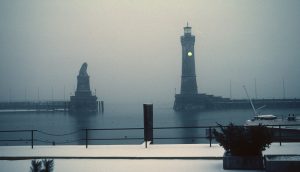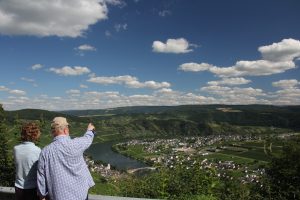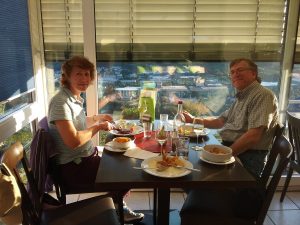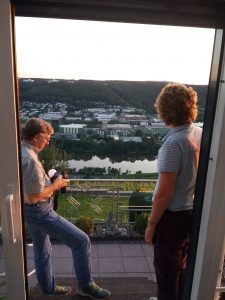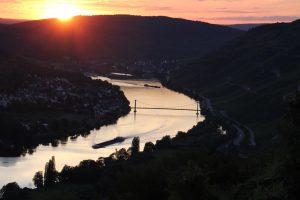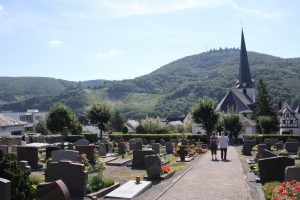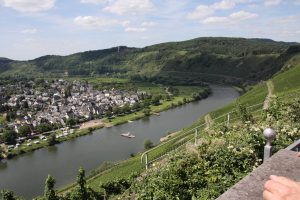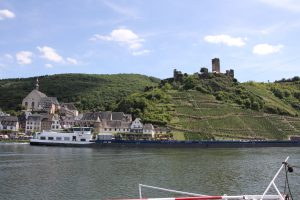Friedrichshafen is a city on the Bodensee, which English speakers call Lake Constance. Bodensee forms part of the border between Germany and Switzerland. I’ve always found it interesting how place names can change so much from one language to another. Paris is always Paris, but in France, London is Londrés.
Anyway, Bodensee sounds cooler to me so that’s what I’ll use.
Our original plans for sightseeing in the Munich (München) neighborhood included going to see Mad Ludwig’s castle at Neuschwanstein. At Marlies’ house, Mary Sullivan told us the story of her and Tom’s visit there the week before. It was a nightmare of trains, buses & walking that took up more than 12 hours. The tour of the interior of the castle was an hour. She didn’t think it was really worth it with so many other things to see.
While we were mulling that information, Marlies told us of a flight she took over the Bodensee in a Zeppelin and how awesome that was. It was expensive but seemed much more interesting to me. I had been harboring hopes of going back to Bodensee anyway. Mary Beth said she’s seen the world from 1000 feet but I said not Bodensee and the Alps.
So she signed on. We made the reservation for Thursday afternoon.
Wednesday afternoon as we were walking to the hotel in Muncih, Mary’s phone rang. It was the Zeppelin people. Thursday’s flight was cancelled due to bad weather. Would we like to reschedule for Friday morning? Yes!
OK, that’s fine. We can go to the Zeppelin Museum in the afternoon, take the flight in the morning, and get the train to Baden Baden in the afternoon. We’ll be at Wilfried’s before dinner time.
When we arrived in Friedrichshafen at about noon on Thursday, we could see why the flight had been cancelled. There was a heavy drizzle and the clouds were so low we could barely see the water of the lake from a block away. The Alps on the other side? Forget it! And the Zeppelin people called again. The Friday morning flight was cancelled. We were sad but not surprised. You wouldn’t have been able to see anything.
At the hotel, we got a map of the town and I noticed another air-related museum. Claude Dornier was a German aircraft designer of the middle 20th Century based near Friedrichshafen. His museum was near the airport, a short train ride away. We decided to go there first and go to the Zeppelin Museum the next morning. Actually, we looked in on the Zeppelin Museum after lunch. It’s right on the water in the Old Town area of Friedrichshafen. It was mobbed. It made sense. The weather was bad and everyone wanted to be inside. We took the train to the other museum.
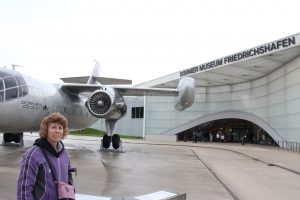
For dinner, we went back to the promenade along the lake and found a restaurant with 2nd floor tables overlooking the lake. The clouds had lifted somewhat and we could see the setting sun shining through the gaps lighting up the Alps. Sehr schön, as they say in Germany.
Sadly, I had left my camera in the hotel room. Mary got some pictures but I don’t have copies yet. Stay tuned!
In the morning we went to the much-less-crowded Zeppelin Museum. Zeppelin, of course, was the airship builder of the early 20th Century. We call them blimps but the craft Zeppelin built were much more than that. Zeppelins had regularly scheduled routes from Germany to the US, to South America and all over Europe in the 1920’s.
The best known example of a Zeppelin is the Hindenburg. The largest such craft ever built, it caught fire and burned in 1937 as it was docking in New Jersey. At the museum, they have a full sized replica of part of the Hindenburg. They also had a smaller display of the Hindenburg in comparison to other famous large aircraft. The Hindenburg dwarfed them all.
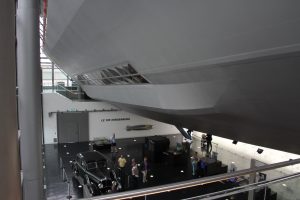
Sorry no photo of the smaller scale models. Maybe Mary has one . . .
When we got out of the museum about 11:30, practically the first thing we saw was the new, tourist, Zeppelin flying over Friedrichshafen. I guess the clouds lifted enough. Here’s Mary watching it fly away.
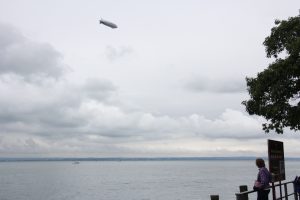
Oh well, maybe next time!
Perhaps I should have known. My other visit to Bodensee was in January 1982. We stayed in Lindau, just a little east of Friedrichshafen, which has a famously beautiful harbor. Visibility was poor that time too.
